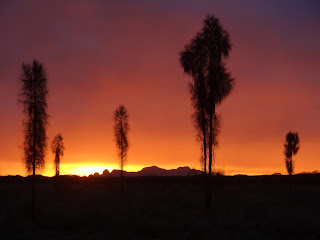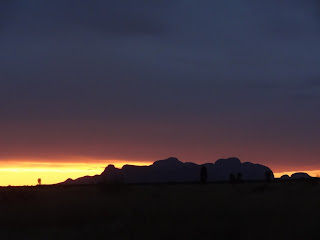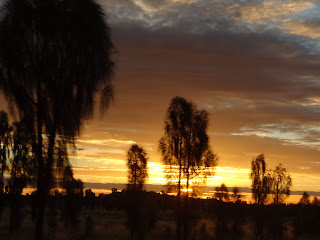Coober Pedy
We headed north the next morning from Adelaide up the center of
Australia following the Stuart Highway on our way to Coober Pedy. Once
leaving the lush coastal areas of the south, the land transforms into
the well known Australian Outback. The Outback reminded us a bit of
the American Southwest. The dry, hot climates and landscapes with wide
open spaces and few small towns in between look relatively similar.
We eventually started getting low on gas and pulled off the highway to
refuel. In our quest for gas we found ourselves in the town of
BLAHBLH. It was an odd little town with no one in site. It looked like
a ghost town and then we came upon a bunch of old rockets, missiles,
jets, cannons and the like and soon realized we were in some sort of
old military base or installation. Turns out they use to use the area
for all sorts of weapons testing and military exercises back in the
day.
Interesting little town but no gas station so we headed back to Stuart
Highway and realized we had driven right past Spud's Roadhouse and Gas
Station. We stopped in fueled up and headed out.
After a several more hours of driving we arrived in Coober Pedy. It
was late but we had called ahead to make sure the Oasis caravan park
was expecting us. They left the gate unlocked for us and we quickly
settled in for the night.
The next morning we set out to explore the unique little mining town
of Coober Pedy. The Oasis front desk was really helpful in giving us a
run down of all that Coober Pedy had to offer. Years ago, beautiful
Opal was discovered in Coober Pedy and people started heading to the
area to make there fortune. The rock and ground that make up Coober
Pedy and the surrounding area is very unique in it's composition.
Miners were able to dig out mine shafts without the need to support
the holes and mines they dug. The rock holds together in an incredibly
stable way. It became standard practice for miners to dig out a place
for their living quarters and then dig their opal mine underneath
their house. These underground homes came to be called dugouts and
were a perfect way to beat the heat and lack of building materials in
the region. They stay at a constant temperature of about 70 degrees
fahrenheit year round. Aboriginals called the place Coober Pedy,
meaning white mans burrows.
Today most Coober Pedy residents still build their homes under ground
and live this way. Many still make a living mining opal and some are
millionaires from it, while others have found little. Todays dugouts
have all the comforts of any modern home. Electricity, water, TV,
Internet, etc. A full dugout home can be excavated/built for about
$5,000, not including the price of the land. Want to add a room, just
pick a wall and start digging.
We visited the Umoona Opal Mine and Museum and got to see what it was
like for the original settlers and miners and how they lived. We also
saw a more modern dugout home. There are actually entire hotels dugout
underground so of course we had to spend the night in one.
We also spent some time fossicking for opals in the old piles of dirt
brought out of the mines. Fossicking is basically digging around in
the dirt looking for gems that were overlooked by the miners. We found
some small bits of opal, nothing worth much but fun keepsakes just the
same.
Along with the opal mine and dugout homes we saw at the Umoona Opal
Mine and Museum, Yani, who runs the place, showed us some amazing
pieces of the most stunning opal you could ever hope to see. We
decided we couldn't leave empty handed and Julie picked out a
beautiful Opal necklace.
On our way out of town we drove to the Dog Fence, the longest
continuous fence in the world. It was built to keep Dingos out of theheart of Australia's sheep and cattle lands. Not much to look at butinteresting non-the less.After Coober Pedy we were on our way to Uluru, (Ayers Roc). After
several more hours of driving, crossing the border into the Northern
Territory, we stopped for gas and chucked a left off the Stuart Hwy
onto the road to Uluru.
A half mile down the road or so we could see a broken down car on the
side of the road and a man standing in the middle of the road near it
trying to flag us down. As we got closer it was clear that the car had
been there for a long time, months, maybe longer...that combined with
the facts that the guy looked fine and the gas station wasn't far away
we decided to just keep on rolling. He nearly tried to block our path
bit we got by. It was odd, but I guess it was a good way to
potentially get people to stop and give you money.
Anyway, we got to Uluru a few hours later just as the sun was setting.
The way the light cut across the sky and shone on the gigantic rock
was really cool.
We found the Uluru caravan park and stayed there for a couple days. We
spent our days relaxing, driving and hiking around. Our nights were
spent watching the sunset from different locations around Uluru and
star gazing. It was really nice.
I was determined to climb Uluru but they rarely have it open for
climbing anymore after several deaths and pressure from local
Aboriginal tribes. We found out that there might be a chance to climb
the next morning if the winds were low so we stayed an extra night and
got up early to make the attempt. I was misinformed as to the location
of the climb so we ended up walking all the way around Uluru before
finding it. Unfortunately it was closed to climbing due to "high
winds". I was about to jump the ropes and head on up anyway but held
off due to the posted $5,000 fine for doing so.
The climbing trail looked amazing. It went up a steep incline on a
narrow path with huge steep drops on either side. There was a hand
rail or ropes going up the middle to help keep people from falling
off. If we ever are here again I'll be sure to wake up extra early,
hop the ropes and do the climb up and down before anyone is the wiser.
Although honestly it did look a bit dangerous and not something most
people should undertake, especially in the way I just outlined.
We really enjoyed the walk around Uluru so that was a great
consolation. During the walk we could hear a large number of Dingos
howling and barking ahead of us. We were getting closer and closer and
weren't sure what was going on. I'll let Julie explain.
Julie Take:
We survived and headed off to Alice Springs.
Uluru
dkfj


























































































































No comments:
Post a Comment